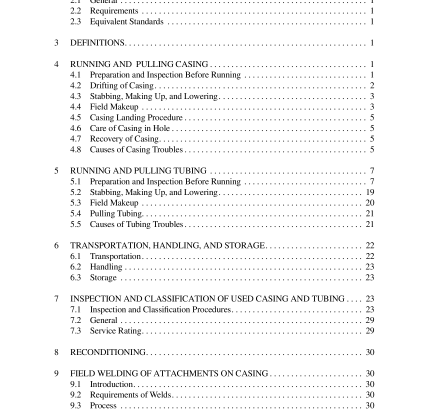API 5C1:2020 pdf free download.Recommended Practice for Care and Use of Casing and Tubing
4.1.2 All casing, whether new, used, or reconditioned, should always be handled with thread protectors in place. Casing should be handled at all times on racks or on wooden or metal surfaces free of rocks, sand, or dirt other than normal drilling mud. When lengths of casing are inadvertently dragged in the dirt, the threads should be recleaned and ser- viced again as outlined in 4.1.7.
4.1.3 Slip elevators are recommended for long strings. Both spider and elevator slips should be clean and sharp and should fit properly. Slips should be extra long for heavy cas- ing strings. The spider must be level. Note: Slip and tong marks are injurious. Every possible effort should be made to keep such damage at a minimum by using proper up-to- date equipment.
4.1.4 If collar-pull elevators are used, the bearing surface should be carefully inspected for (a) uneven wear that may produce a side lift on the coupling with danger of jumping it off, and (b) uniform distribution of the load when applied over the bearing face of the coupling.
4.1.5 Spider and elevator slips should be examined and watched to see that all lower together. If they lower unevenly, there is danger of denting the pipe or badly slip-cutting it. 4.1.6 Care shall be exercised, particularly when running long casing strings, to ensure that the slip bushing or bowl is in good condition. Tongs may be sized to produce 1.5 percent of the calculated pullout strength (API Bulletin 5C3) with units changed to ft-lb (N • m) (150 percent of the guideline torque found in Table 1). Tongs should be examined for wear on hinge pins and hinge surfaces. The backup line attachment to the backup post should be corrected, if necessary, to be level with the tong in the backup position so as to avoid uneven load distribution on the gripping surfaces of the cas- ing. The length of the backup line should be such as to cause minimum bending stresses on the casing and to allow full stroke movement of the makeup tong.
4.1.7 The following precautions should be taken in the preparation of casing threads for makeup in the casing strings: a. Immediately before running, remove thread protectors from both field and coupling ends and clean the threads thor- oughly, repeating as additional rows become uncovered. b. Carefully inspect the threads. Those found damaged, even slightly, should be laid aside unless satisfactory means are available for correcting thread damage. c. The length of each piece of casing shall be measured prior to running. A steel tape calibrated in decimal feet (millime- ters) to the nearest 0.01 feet (millimeters) should be used.
The measurement should be made from the outermost face of the coupling or box to the position on the externally threaded end where the coupling or the box stops when the joint is made up power tight. On round-thread joints, this position is to the plane of the vanish point on the pipe; on buttress-thread cas- ing, this position is to the base of the triangle stamp on the pipe; and on extreme line casing, this position is to the shoul- der on the externally threaded end. The total of the individual lengths so measured will represent the unloaded length of the casing string.
The actual length under tension in the hole can be obtained by consulting graphs that are prepared for this purpose and are available in most pipe handbooks. d. Check each coupling for makeup. If the standoff is abnor- mally great, check the coupling for tightness. Tighten any loose couplings after thoroughly cleaning the threads and applying fresh compound over entire thread surfaces, and before pulling the pipe into the derrick. e. Before stabbing, liberally apply thread compound to the entire internally and externally threaded areas. It is recom- mended that a thread compound that meets the performance objectives of API Bulletin 5A2 be used; however, in special cases where severe conditions are encountered, it is recom- mended that high-pressure silicone thread compounds as specified in API Bulletin 5A2 be used. f. Place a clean thread protector on the field end of the pipe so that the thread will not be damaged while rolling pipe on the rack and pulling into the derrick. Several thread protectors may be cleaned and used repeatedly for this operation. g. If a mixed string is to be run, check to determine that appropriate casing will be accessible on the pipe rack when required according to program. h. Connectors used as tensile and lifting members should have their thread capacity carefully checked to ensure that the connector can safely support the load. i. Care should be taken when making up pup joints and con- nectors to ensure that the mating threads are of the same size and type.
4.2 DRIFTING OF CASING
4.2.1 It is recommended that each length of casing be drifted for its entire length just before running, with mandrels conforming to API Specification 5CT. Casing that will not pass the drill test should be laid aside.API 5C1 pdf download.API 5C1:2020 pdf free download
